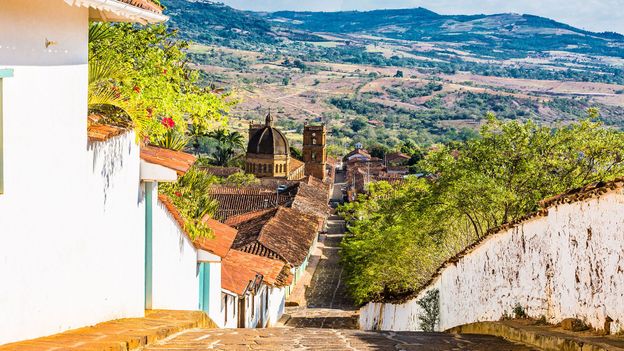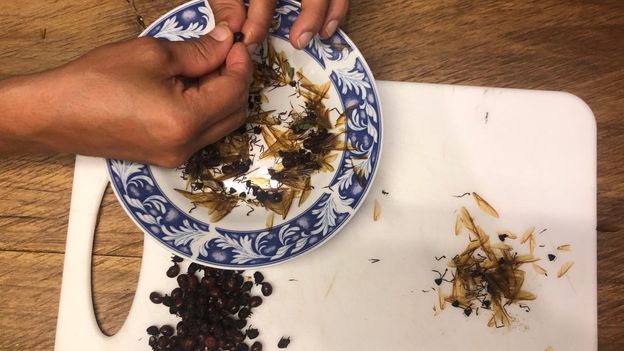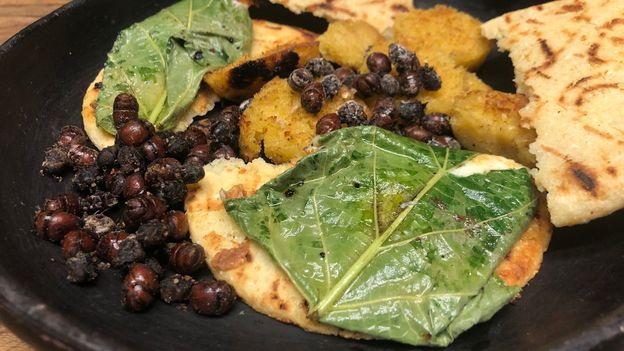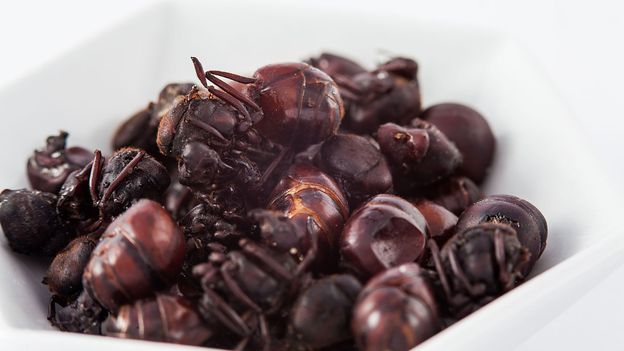The most important day of the year in Barichara, a colonial town in the Colombian Andes, is not Christmas, New Year or Easter, but what locals excitedly call La Salida, or “The Exit”.
When that day arrives, a palpable sense of anticipation surges through Barichara’s cobblestone streets and whitewashed buildings. Street sweepers and domestic cleaners throw down their tools mid-work, children sneak out of school and shopkeepers disappear without a trace.

Colonial Barichara is considered one of Colombia's most attractive towns. Every year during La Salida, residents here disappear to hunt for ants (Credit: Ostill/Getty Images)
They are all in search of the precious hormigas culonas, or “big-butt” ants, that are considered the caviar of Colombia’s north-central Santander region. Each spring as millions of these ample-bottomed insects hatch in the surrounding countryside, the annual harvest frenzy ensues.
“It’s first-come, first-serve,” said Margarita Higuera, a psychologist-turned-chef who moved to Barichara in 2000. “If you can get a bucket on top of an ant nest, then it is yours to keep no matter if you own the land or not.”
Taking place around March or April each year, when the sun shines brightly following days of heavy rainfall and the moon is full, La Salida marks the beginning of the ants’ annual mating season, which can last for up to two months, during which time locals scramble to collect as many queen ants as they can. Bloated with eggs and ready to reproduce, the brown, cockroach-sized queens are prized for their rotund, pea-shaped bottoms, which can taste like peanuts, popcorn or even crispy bacon when roasted and salted.

After the harvest, locals peel the queen's wings from its shapely body in preparation for cooking (Credit: Peter Yeung)
“For me, the flavour is unique,” said Higuera, while plucking the papery wings off ants that filled a small pot on her kitchen table. “It reminds me of my past. I remember one time when my grandfather bought a barrel full of them and you could hear them all crawling inside. The whole family sat around it preparing them one by one.”
"It can be tough work. The colonies don’t let you take their queens away easily"
The queen ants are savoured as a delicacy and munched by the handful on street corners, fried on the stoves of working-class homes and featured on tasting menus of high-end restaurants across Colombia. In fact, 1kg of these insects can fetch as much as 300,000 pesos (£65), making them several times more valuable than Colombia’s world-famous coffee. As a result, they’re also a healthy source of income for locals.
“I can earn a week’s wages in a single day through collecting hormigas,” said Federico Pedraza, who works as a street cleaner in Barichara. “But it can be tough work. The colonies don’t let you take their queens away easily.”

With their pea-shaped bottoms, these roasted, fried or salted queen ants are considered the caviar of Colombia’s north-central Santander region (Credit: Peter Yeung)
Wearing ankle-high rubber boots and long sleeves for protection, collectors must work quickly because the soldier ants of the colony, who are tasked with protecting the queens from predators, can inflict painful bites that draw blood. Villagers scattered in the fields deposit the mouth-watering queens into anything at handbags, jugs, pots, sacks – working frantically through the daylight hours. But the rewards are considerable, especially for diners.
As well as being an excellent source of protein, the atta laevigata species, also known as the South American leafcutter ant, is a rich source of unsaturated fatty acids, which prevent high cholesterol. Other research published in the journal Frontiers in Nutrition has revealed that ants contain high levels of antioxidants and that regular consumption of them could help prevent cancer.
“That’s the reason why us baricharas (locals) usually live long, healthy lives,” said Cecilia González-Quintero, a shopkeeper who has been preserving and selling the ants in glass jars for 20 years. “The ants give us a special strength – [especially] the ones with the juicy culonas (big butts).”

Ants are rich in antioxidants and research has shown that eating them can help prevent cancer (Credit: Peter Yeung)
Hormigas culones have been consumed in and around Santander for roughly 1,400 years. According to historical records, the native Guane people of central Colombia first began cultivating and cooking the insects in the 7th Century, and they used the ants’ sharp pincers as stitches to heal wounds. Later the marauding Spanish conquistadors adopted the habit.
"That’s the reason why us baricharas (locals) usually live long, healthy lives," she said.
Perhaps due to the circumstances in which they are caught – on the amorous cusp of reproduction – the ants are also considered an aphrodisiac and are often gifted in ceramic pots as a wedding present. This custom is particularly common among indigenous Andean communities known as pati amarillos, or “yellow feet” people, so named after the orange-yellow earth on which they walk and with which they build their traditional adobe homes.
In the nearby city of Bucaramanga, enormous metal sculptures have been erected in homage to the insects. Colourful murals depicting them can be seen on walls all around town. Taxi drivers stop to snack on handfuls of crunchy, roasted hormigas, and children play with small, furry ant toys.

In recent years, a growing appetite for this crawling culinary specialty has seen the ants spread from a regional snack to something of a gourmet ingredient. Each spring, harvesters send truckloads of the queens to hungry buyers across Colombia. Even experimental, high-end restaurants in the country’s capital, Bogotá, feature them seasonally – such as at Mini-Mal, where the ants are served alongside smoked Amazonian pirarucu fish or as part of an ant-infused black pepper sauce with roast beef to a daring clientele.
“Hormigas are an important part of Colombian cuisine,” said the restaurant’s chef Eduardo Martínez, who first tasted them on a family trip to Santander as a nine-year-old. “I want to promote their use and ensure that this tradition survives.”
But in recent generations, a combination of deforestation and urbanisation has led to problems between the ants and people in Santander. Population growth has seen the insects dig into the foundations of buildings and clash with farmers, whose crops are being eaten by ravenous leafcutters.

In addition, climate change has affected the reproductive cycle of the ants, as extreme, erratic weather has knocked the colonies’ essential balance of humidity, sun and rainfall out of kilter. Because their mating season relies on very specific weather conditions, if the ground isn't soft enough, the queens might not be able to emerge from their underground tunnels easily. And similarly, deforestation and urbanisation is affecting the natural habitats of the ants, limiting where the nests can spread.
"If the right conditions aren’t present, the ants might not be born or they might not be able to escape from the ground."
“The ecosystem is changing,” said Aura Judit Cuadros, a independent researcher in Bucaramanga who is studying ways to breed the ants sustainably for large-scale consumption. “If the right conditions aren’t present, the ants might not be born or they might not be able to escape from the ground.”
From the rolling foothills of Barichara to the valleys that encircle the towns of San Gil, Curití, Villanueva, and Guane, however, the enduring ubiquity of these treasured insects means that their disappearance is not yet a serious concern.

When I visited, Alex Jiménez, a guide and ant expert from the area, prodded the entrance to a hormiguero, or ant nest, with a long tree branch. Soon several irritated soldier ants emerged to investigate the disturbance, marching around in search of the perpetrator. According to Jiménez, each nest contains many thousands of ants and can extend 5m underground in a vast labyrinth of tunnels that would stretch for miles if laid straight. Curiously, the queen of the nest can live for up to 15 years, but when she dies, the colony must move and build a new one.
“These ants have a certain intelligence, a natural one,” said Jiménez, peering at the line of leafcutters carrying cuts of foliage above their tiny abdomens. “They work as one to ensure the survival of the whole. They’ve been collected and eaten for hundreds of years. They won’t die out.”
As if to prove the point, the Santander native recounted a memorable 6km bike ride with friends during the peak of mating season last year. Jiménez said the cycle through the countryside should have taken 30 minutes, but it ended up lasting nearly four hours as the group, overwhelmed by the sight of ants, could not help but stop every few minutes to collect more and more. They were seemingly joined on the hillsides by entire villages, eager to take part in this centuries-old Colombian and pre-Columbian tradition.
“The whole town smelt of hormigas that night,” he exclaimed. “Hormigas! Hormigas! Hormigas!”
Latest Stories
-
We haven’t received any directive to halt over-the-counter dollar withdrawals – Bankers Association
5 minutes -
The Makers House Chapel opens an inclusive Sunday School unit, giving hope to families with Special Needs children
42 minutes -
Acting in US Law & Order series was my biggest deal – KSM
45 minutes -
Ghana’s film industry has ingredients but lacks recipe – KSM
58 minutes -
Presidency’s decision on Sammy Gyamfi gifting saga baseless – Haruna Mohammed
1 hour -
GRA dismisses claims of SML mandate expansion
1 hour -
Illegal gold trade: We won’t treat culprits with kid gloves – GoldBod
2 hours -
CHRAJ petition to investigate Sammy Gyamfi withdrawn
2 hours -
Tema-Mpakadan rail line to be operational soon – Railway Dev’t Authority CEO
2 hours -
When safe gets softer: Declining T-bill yields and search for alternatives
2 hours -
NPP bans internal campaigns until nominations are opened
2 hours -
Joy FM’s aKorfa to travel to Asia with one lucky listener
3 hours -
Committee probing CJ removal petitions to begin hearings tomorrow
3 hours -
When Democracy Doesn’t Deliver: Lessons from Burkina Faso
3 hours -
Beyond Sight: Emmanuel Dela Mensah, Ghana’s Goalball ‘Messi’
3 hours

